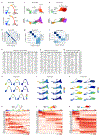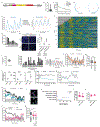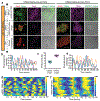In vitro characterization of the human segmentation clock
- PMID: 31915384
- PMCID: PMC7336868
- DOI: 10.1038/s41586-019-1885-9
In vitro characterization of the human segmentation clock
Abstract
The segmental organization of the vertebral column is established early in embryogenesis, when pairs of somites are rhythmically produced by the presomitic mesoderm (PSM). The tempo of somite formation is controlled by a molecular oscillator known as the segmentation clock1,2. Although this oscillator has been well-characterized in model organisms1,2, whether a similar oscillator exists in humans remains unknown. Genetic analyses of patients with severe spine segmentation defects have implicated several human orthologues of cyclic genes that are associated with the mouse segmentation clock, suggesting that this oscillator might be conserved in humans3. Here we show that human PSM cells derived in vitro-as well as those of the mouse4-recapitulate the oscillations of the segmentation clock. Human PSM cells oscillate with a period two times longer than that of mouse cells (5 h versus 2.5 h), but are similarly regulated by FGF, WNT, Notch and YAP signalling5. Single-cell RNA sequencing reveals that mouse and human PSM cells in vitro follow a developmental trajectory similar to that of mouse PSM in vivo. Furthermore, we demonstrate that FGF signalling controls the phase and period of oscillations, expanding the role of this pathway beyond its classical interpretation in 'clock and wavefront' models1. Our work identifying the human segmentation clock represents an important milestone in understanding human developmental biology.
Figures











Comment in
-
The clock that controls spine development modelled in a dish.Nature. 2020 Apr;580(7801):32-34. doi: 10.1038/d41586-020-00322-y. Nature. 2020. PMID: 32238938 No abstract available.
-
[The human segmentation clock rings every five hours].C R Biol. 2020 Jun 5;343(1):7-8. doi: 10.5802/crbiol.11. C R Biol. 2020. PMID: 32720482 French. No abstract available.
References
MeSH terms
Substances
Grants and funding
LinkOut - more resources
Full Text Sources
Other Literature Sources
Molecular Biology Databases
Miscellaneous

